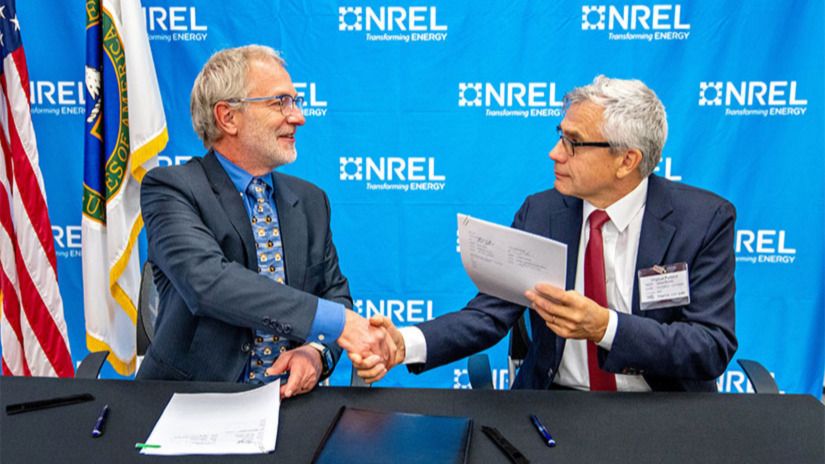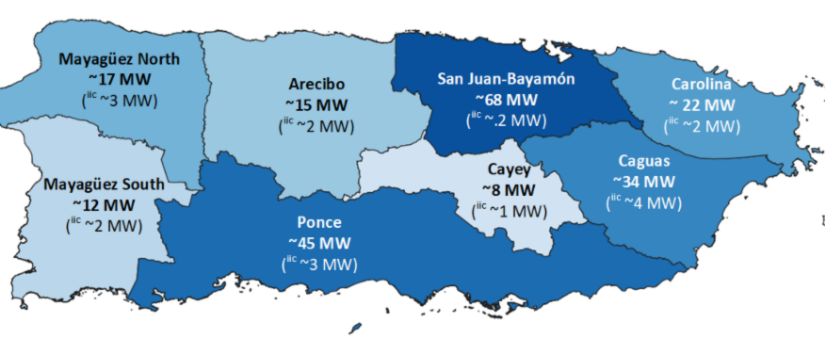Energy Systems Integration Newsletter: November 2022
In this edition, NREL and the Lithuanian Energy Agency launch a multiyear study of pathways to 100% clean electricity in Lithuania, we look back on a decade of partnership and innovation with Hewlett Packard Enterprise, new software helps utilities and grid operators track threats, and more.

100% Clean Electricity for Lithuania: NREL Commits to Multiyear Research Collaboration
NREL is applying its analysis and expertise to another large-scale energy system transition. Working with the Lithuanian Energy Agency (LEA), NREL will investigate a range of scenarios using software and modeling tools that have achieved deep insights for other energy transitions, such as Los Angeles and Puerto Rico.
The 4-year agreement focuses on 100% clean energy pathways, distribution grid planning, opportunities for hydrogen integration, and reducing greenhouse gas emissions. NREL and LEA will produce a report with results from the analysis, featuring a full feasibility analysis of options—including planning for public health, equitable and local economic development, and job opportunities. The path to 100% renewable energy will be a major step for Lithuania, which is also working toward energy independence.
“In order to move toward 100% renewable energy and to decarbonize our industry, we will need to more than triple the amount of renewable energy generation in Lithuania,” Lithuanian Minister of Energy Dainius Kreivys said. “This is a big challenge for a country that today still imports two-thirds of its electricity.” Read the full Lithuania clean electricity story.
NREL and Hewlett Packard Enterprise Build on Years of Groundbreaking Innovation
The partnership between NREL and Hewlett Packard Enterprise (HPE) has pushed the lab into the leading edge of high-performance computing. Eleven years ago, HPE installed Peregrine—NREL’s first supercomputer—at the Energy Systems Integration Facility. The relationship between the building and the supercomputer has garnered several research and development and sustainability awards.
Eagle—Peregrine’s successor—has been used in several high-impact projects, including the LA100 study; the digital twin of Dallas-Fort Worth International Airport, Athena; and wind power simulations ExaWind. As NREL looks to the future with Kestrel—the lab’s third HPE-built supercomputer—we reflect on more than a decade of partnership and innovation.
Utilities Can Stop Cyber Intrusions With IViz-OT
A new NREL software—IViz-OT (Intrusion Detection Visualizer for Operational Technology Network)—can assist utilities and grid operators with tracking cyber and physical threats and intrusions on distribution systems. IViz-OT processes grid data to deliver real-time awareness to operators. It visualizes the grid’s state and sends alerts to operators for both information technology and supervisory control and data acquisition-specific attacks. IViz-OT is hardware agnostic, customizable to users’ systems, and available for licensing. Read the full story about IViz-OT’s release.
Q&A With Stephanie Bostwick: Capacity Building and Energy Sovereignty for Tribal Nations
From reducing utility bills to improving air quality, different communities have different priorities for their clean energy future. For Stephanie Bostwick’s American Indian partners, the primary concern is energy sovereignty. Bostwick is an NREL project manager who supports technical assistance for tribal nations and is a member of the Amskapi Pikuni, also known as the Blackfeet Nation. For Native American Heritage Month, she explains why building a tribal workforce is critical to ensuring that thoughtful decisions are made and that tribes can employ their members to maintain renewable energy systems.
Read more about the clean energy transition for American Indian tribes in our latest Q&A.
NREL and Sacramento Municipal Utility District Launch Automation Tool for Interconnecting Customer Solar to the Grid
The push by states and local governments to reach higher renewable energy goals has brought an influx of applications to connect photovoltaic systems to the power grid.
To reduce the workload on already heavily burdened distribution engineers, NREL worked closely with the Sacramento Municipal Utility District (SMUD) to develop PRECISE™ (PREconfiguring and Controlling Inverter Set-points). The tool performs fast and automated interconnection assessments and seamlessly integrates with SMUD’s existing business interconnection workflow.
PRECISE assesses what size of system the grid can accommodate and identifies optimal inverter settings for that location. Since launching at SMUD, PRECISE has processed an average of 13 applications per day. That is a huge advancement in efficiency from what had previously been a manual process, reducing wait times and costs.
Read more about the capabilities of PRECISE and the potential downstream impact of implementing this technology.
Strategic Planning Could Maximize Benefits of Integrating Electric Vehicles Into Electrical Distribution Systems
In this installment of NREL’s Tell Me Something Grid series, Nadia Panossian, a member of NREL’s Grid Planning and Analysis Center, shares her thoughts on how distribution systems can plan for increased demand with electric vehicles.
Panossian describes how recent NREL research suggests that if distribution system planning is done right, super high adoption of electric vehicles doesn’t have to strain the grid, and system planners can largely avoid costly system upgrades.
Learn more in NREL’s latest Tell Me Something Grid article by Nadia Panossian.
NREL Supports Eighth Annual CyberForce Competition
Over Nov. 4–5, 2022, more than 150 collegiate teams gathered to defend a virtual solar facility from a staged cyberattack for the U.S. Department of Energy’s annual CyberForce Competition. The competition is part of the CyberForce Program, which seeks to inspire and develop the next generation of energy cyber defenders. The realistic simulation allows students to flex their skills, practice teamwork, and find out if they are up for a career safeguarding critical infrastructure. NREL staff supported the competition alongside other national lab cybersecurity experts. Congratulations to the University of Central Florida Team A on winning this year’s competition.
Interested in a career in energy cybersecurity? Check out our Meet an NREL Cybersecurity Expert video series, where NREL cyber researchers share what it’s like to work at a national lab and how they’re making a difference.
Puerto Rico Resilience: New Publication Reviews Microgrid Possibilities
In the aftermath of powerful hurricanes and sustained power outages, Puerto Rico is rethinking its power grid for future resilience, efficiency, and affordability. Microgrids could contribute to all three objectives, but technical and planning hurdles must be considered first. As part of the PR100 study to integrate 100% renewable energy, NREL published guidance around what is needed for Puerto Rico to deploy a system of microgrids throughout the island. The publication is Energy Resilient Recovery in Puerto Rico: Hurricane Maria Recovery Support.
This report, funded by the Federal Emergency Management Agency, discusses Puerto Rico’s options for dividing the power grid into a network of “islandable” sections. Starting from a configuration proposed by Puerto Rico’s utility in 2019, the authors analyze the capacity and islanding ability of each minigrid territory, as shown in the figure.
A proposed configuration of regional minigrids in Puerto Rico. The numbers indicate
photovoltaic solar capacity, and the amounts in parentheses indicate the capacity
for intentional islanding.

The authors then discuss the challenges and requirements for microgrids generally. They discuss different control levels and timescales and the relevant standards to employ such controls. They also review the modeling and simulation tools that can help Puerto Rico prepare for microgrid integration. The authors emphasize that because of a lack of working knowledge in this area, there are many issues to analyze, including market integration, grid support, and device protection. However, the report provides resources to explore these issues and recommends where to direct future work.
Distributed Energy Resource Technologies That Show the Most Promise
The deployment of distributed energy resources (DERs) is increasing in many parts of the United States. NREL—in collaboration with utilities, vendors, and researchers—is studying the effects of increasing levels of DERs to find the most cost-efficient integration approaches while maintaining reliable grid operations. In a recent T&D World article, NREL’s Francisco Flores-Espino briefly describes the technical and financial assessments performed on different DER technologies thus far and NREL’s plans for the near future. Read Flores-Espino’s guest contribution in T&D World.
Increased Solar Panel Spacing Comes With Benefits
A recent NREL analysis found that increased spacing between rows of solar panels can boost efficiency and improve economics in certain instances. As solar panels capture and convert sunlight to electricity, the accompanying heat can slightly decrease power output. More space between rows allows for greater wind flow, potentially resulting in lower module temperatures and higher energy output. The findings could be particularly relevant to the growing field of agrivoltaics, in which land is used for agriculture and producing solar photovoltaic power. Read more about the benefits of increased solar panel spacing.
Share
